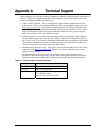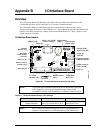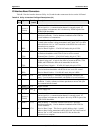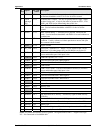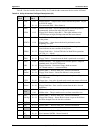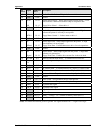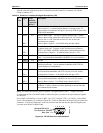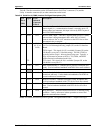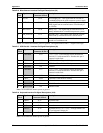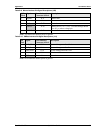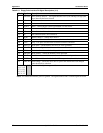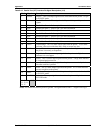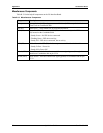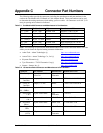
Appendix B I/O Interface Board
28 QuickStart Guide CoreModule 800
Table B-4 lists the connections on the I/O Board between the Serial Port 1 connector (J7) and the
Utility 1Connector (J1).
Table B-4. Serial Port 1 Interface Pin/Signal Descriptions (J7B)
J7
Pin #
Signal From
Onboard
Connector
& Pin #
Description
1 DCD1* J4-1 Data Carrier Detect 1 – Indicates external serial device is detecting a
carrier signal (i.e., a communication channel is currently open). In
direct connect environments, this input is driven by DTR1 as part of the
DTR1/DSR1 handshake.
2RXD1
RX1-
J4-3 Receive Data 1 Input – This line is typically held at a logic 1 (mark)
when no data is being transmitted, and is held “Off” for a brief interval
after an “On” to “Off” transition on the RTS1 line to allow the
transmission to complete.
Receive Data 1 Negative – If in RS485 mode, this pin is RX1-.
3TXD1
TX1-
J4-5 Transmit Data 1 Output – This line is typically held to a logic 1 when
no data is being sent. Typically, a logic 0 (On) must be present on
RTS1, CTS1, DSR1, and DTR1 before data is transmitted on this line.
Transmit Data 1 Negative – If in RS485 mode, this pin is TX1-.
4DTR1*J4-7
Data Terminal Ready 1 – Indicates port is powered, initialized, and
ready. Used as hardware handshake with DSR1 for overall readiness.
5 GND J4-9 Ground
6DSR1*J4-2
Data Set Ready 1 – Indicates external serial device is powered,
initialized, and ready. Used as hardware handshake with DTR1 for
overall readiness to communicate.
7RTS1*
TX1+
J4-4
Request To Send 1 – Indicates serial port is ready to transmit data.
Used as hardware handshake with CTS1 for low level flow control.
Transmit Data 1 Positive – If in RS485 mode, this pin is TX1+.
8CTS1*
RX1+
J4-6 Clear To Send 1 – Indicates external serial device is ready to receive data.
Used as hardware handshake with RTS1 for low level flow control.
Receive Data 1 Positive – If in RS485 mode, this pin is RX1+.
9RI1* J4-8
Ring Indicator 1 – Indicates external serial device is detecting a ring
condition. Used by software to initiate operations to answer and open
the communications channel.
Notes: The shaded area denotes power or ground. The signals marked with * = Negative true logic.
To implement the two-wire RS485 mode on either serial port, you must tie the equivalent pins together
for each port.
For example; on Serial Port 1, tie pin 2 (RX1-) to 3 (TX1-) and pin 7 (TX1+) to 8 (RX1+) at the (DB9)
Serial 1 port connector (J7) as shown in Figure B-2. Refer to either table for the specific pins on the port
connectors. The RS-422 mode uses a four-wire interface and does not need any pins tied together, but
you must select RS-485 in BIOS Setup.
CM800QkS_13a
Standard DB9 Serial
Port Connector (Female)
Rear View
54321
9876
Figure B-2. RS-485 Serial Port Implementation




